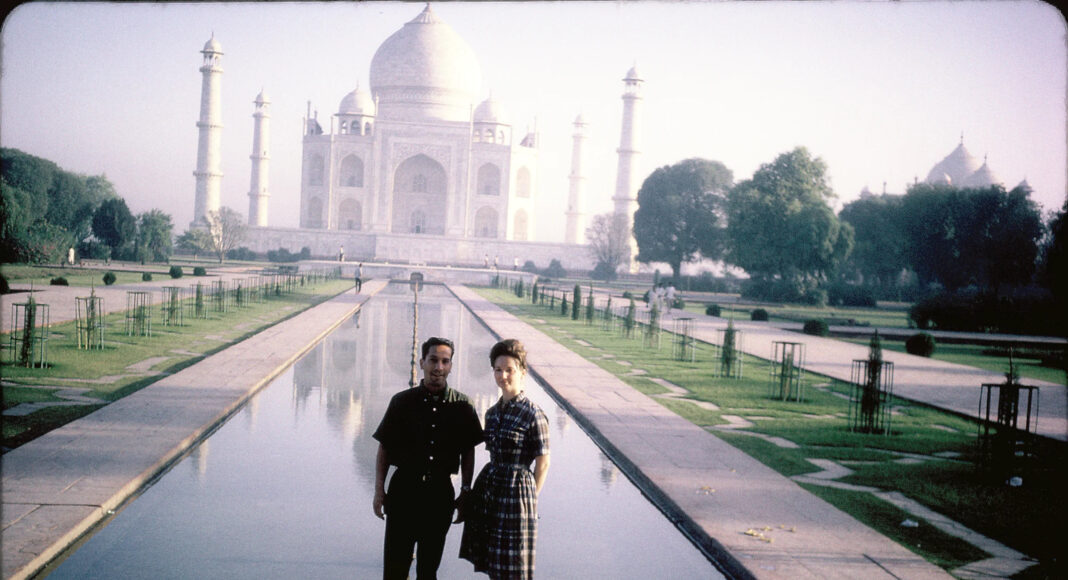Dusty slides from worldly adventures in 1965 provided exactly the intergenerational Kodak moment I needed to contextualize my own travels around San Jose.
I was not even alive in 1965, but my parents were. That year, they escaped San Jose for three glorious months, traveling all over Japan, Hong Kong, Rome, Naples, Florence, Paris, Germany and London. Their globetrotting spectacle even included six weeks in India before they eventually gave up and came back home. Yet I had never seen the photos until last week.
Over the last 17 years in this space, I have undertaken various irregular journeys through ignored San Jose locales, producing columns that resonated with many readers, but I often felt like something was missing from the delivery. Especially in the beginning, it seemed like I was still navigating a smokescreen, or maybe I didn’t have the right arsenal to provide historical context. Now I’m closer.
A 1965 photo of my parents at the Taj Mahal was so haunting that I felt driven to better understand the way in which I explored the suburban backwaters of San Jose. The abandoned strip malls, the ruins, the ghosts and the crumbling wreckages of history that appeared in my columns were not assigned by the Mughal Emperor Shah Jahan, as was the Taj Mahal, but a transnational spirit of adventure seemed to flow through my bloodstream. It was in my DNA. Something was propelling me to reconnect with, well, something.
The photo spoke to me. The traveler’s journey is not just spatial, but also temporal. Sometimes the context doesn’t emerge until decades later. That’s how history works. My parents arrived in India right between two generations of heroes, the Beats and the Beatles, an insane juxtaposition to which I will now turn.
In the former case, I am reminded of Allen Ginsberg, Gary Snyder and a few others, whose discombobulated trajectories through India were documented in Deborah Baker’s fantastic book, A Blue Hand: The Beats in India. As anyone should expect, it is not a normal book. There is no conventional narrative structure, but A Blue Hand is a deftly woven work of both scholarship and entertainment. Did Ginsberg’s eastward turn ultimately fail? Was he wasting his time? Baker did such a wonderful job that English Patient author Michael Ondaatje blurbed the book, calling Baker “the biographer as adventurer.” I like that term. Also, Baker’s husband is the legendary Indian novelist Amitav Ghosh, making them my second favorite half-white, half-Indian couple of all time, after my parents.
Then came the Fab Four. The Beatles left a much more lasting impression. George Harrison was my favorite one. My dad first turned me on to the Sgt. Pepper’s album when I was about seven years old—probably the first time I ever heard a sitar.
What’s more, nowadays one cannot experience the Taj Mahal as my parents did in this photograph. Much-publicized pollution has given the building a yellow sludge color. The air is thick with muck. Even at dawn, one must tolerate a zillion people just to see the place. There is no such moment when the grounds are empty and clear under the sunlight, as in this photo.
The funniest thing of all is that during the three months they traveled, my mom had a job back home in San Jose and was supposed to be working the whole time. It took some finagling, but her boss eventually let her do the trip. Oddly enough, I would later recreate the same behavior at several different jobs, not realizing my mom had done so before I was born. The only difference was I rarely cared if I still had a job after I came back.
These days, though, after all the columns in which I scoured forgotten areas of San Jose or its history, maybe I was looking for that long-lost Taj Mahal buried somewhere in my DNA. Or, even better, maybe the discovery of this photo was simply a reminder that I’m on the right path. I have not wasted a second of my life. No matter what happens, you can expect still more slices of San Jose to appear on this page. Carry on, wayward son!



